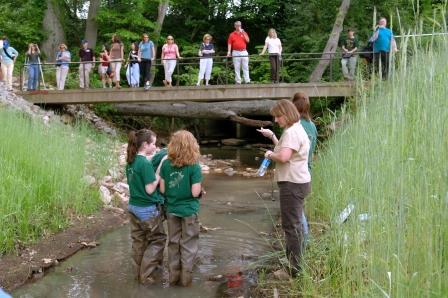Cracking the Culvert: Urban Stream Restoration in North Carolina

At different points in their histories, Little Sugar Creek and Rocky Branch represent the best and worst of North Carolina streams.
Both creeks run through bustling cities. Both have been listed among the state’s most polluted urban streams. And both waterways were forced into pipes and buried underground to pave the way for progress. Few people even knew they existed.
“For years, most people didn’t even realize we have a stream on campus,” Barbara Doll, water quality specialist for North Carolina Sea Grant, says about Rocky Branch, which flows more than a mile through North Carolina State University in Raleigh. “When you’d ask people about it, they’d say, ‘Oh, you mean the ditch out behind the gym?'”
Little Sugar Creek in Charlotte shares a similar story of oblivion.
“You’d be in line at the drive-through of McDonald’s on Kings Drive, and you’d be sitting on top of the creek,” says Crystal Taylor, an engineer for Charlotte-Mecklenburg Storm Water Services, describing the paved-over stream. “You didn’t even know it was there.”
But today, Rocky Branch and Little Sugar creeks are becoming international models for stream restoration success. Once ugly eyesores of straightened channels, crumbling stream banks and weedy brush, the creeks are undergoing dramatic facelifts that go far beyond the aesthetic.
Water quality specialists, engineers and officials in both cities are recreating more natural channels for the streams — complete with meandering turns, natural pools for insects and fish, stabilized stream banks, small wetlands and increased floodplain areas to help prevent flooding and filter pollutants from runoff. Greenways are being built alongside the restored waterways for pedestrian and cyclist enjoyment, as well as educational opportunities.
The latest and most dramatic aspect of restoring the two streams involves “daylighting,” or puffing culverts out of the ground.
In Raleigh, plans are underway to expose 235 feet of Rocky Branch behind NC State’s Carmichael Gymnasium, completing the multi-phased restoration effort that began nearly 10 years ago. The stream feeds into Walnut Creek, a tributary of the Neuse River, which flows to the Pamlico Sound.
In Charlotte, 950 feet of Little Sugar has already been unearthed from a parking lot in the Midtown Square area between Charlottetowne Avenue and Baxter Streets. Officials are now digging out more than 1,300 feet along Kings Drive, from Baxter to Morehead Streets. The creek drains into the Catawba watershed, which flows through several lakes into the Santee River Basin and out to the Atlantic.
“Daylighting represents a new way of thinking about how creeks and watersheds should fit into our urban ecosystems,” Doll says. “In many ways, it’s a form of rebirth for the streams — we’re at ground zero and coming up.”
STABILIZING STREAMS
The practice of daylighting is fairly new, notes Richard Pinkham, an environmental consultant and author of “Daylighting: New Life for Buried Streams,” a demonstrative report written for the federal Environmental Protection Agency in the 1990s.
The first daylighting projects in the United States occurred during the 1970s in California and Illinois. The practice wasn’t widely recognized until 1984, when Strawberry Creek was unearthed from a park in Berkeley, Calif.
The project is considered by many to be the archetype of daylighting, Pinkham notes. Since then, such projects have become increasingly common in larger metropolitan areas, including the daylighting of the Saw Mill River in Yonkers, N.Y., as well as Taylor Creek in Seattle.
In North Carolina, an estimated three stream restoration projects involving daylighting are underway — Rocky Branch, Little Sugar, and Mine Creek, part of the Big Branch watershed in north Raleigh. Flooding problems initiated the Mine Creek project.
“We were getting complaints from nearby residents,” explains Mark Senior, an engineer for Raleigh’s Stormwater Management Division. The flooding resulted from a developer forcing the creek into a “woefully undersized” pipe underground. In this case, it was cheaper for the city to expose the stream than replace the culvert.
“In the old days, we might have thrown rip rap on it or concrete,” Senior says, referring to the exposed part of the stream.
But that approach, known as “armoring,” doesn’t help recover the floodplain connection, according to Doll. Having a floodplain, or a natural low-lying area adjacent to a waterway, is a key ingredient for a stable stream.
‘Today, engineers and scientists are moving more towards natural channel design,” Doll says. This method strives to return the natural form of a stream by adding bends, or “meanders,” and sizing the channel so it connects to a floodplain.
Urban streams are typically cut off from their natural floodplains, which have been paved over and developed into shopping centers, houses and parking lots. To prevent flooding, developers often straightened, widened and deepened — or “channelized” — streams to increase water flow. But this gives water more energy to move sediment, which increases erosion, Doll explains.
“Usually, that erosion starts on the bed of the channel, and these streams literally start to incise, or downcut,” she says. When a stream downcuts several feet, its banks can no longer support their own weight. “That’s when you start seeing slumping or failing of the stream banks,” Doll notes.
Unearthing culverts from the ground can help reduce erosion and increase a stream’s hydraulic capacity by recreating a vegetated floodplain, she explains. “Vegetation is key to holding a natural channel together.”
URBAN CHALLENGES
But stream restoration in urban areas isn’t just digging up creeks and planting pretty trees.
In addition to a significant amount of earthmoving, daylighting even a small part of an urban stream is expensive and difficult to coordinate. Projects can cost millions of dollars, and the physical constraints inherent to city environments — such as roads, overpasses, property lines, easements, and utility cables — present unique challenges.
Scott McLendon of the U.S. Army Corps of Engineers encourages scrutiny of such projects to make sure citizens are getting the most bang for their bucks.
“Most, if not all of these projects are being done with taxpayer money,” says McLendon who works in the USAGE’S Regulatory Program office in Wilmington.
Funding for stream restoration typically comes from a mix of local, state, federal and nonprofit sources and grants. Restoring Little Sugar has already cost $21 million, and remaining projects on the creek are estimated to total $31 million. Rocky Branch’s price tag is already $3.8 million, and the daylighting phase will cost an estimated $2 million.
“You can spend a lot of money to build a very aesthetic channel, but that may not improve the water quality of the stream — one stretch of restored stream by itself will not repair the entire stream corridor,” McLendon says.
Rural stream projects tend to be easier and cheaper to fix, he adds. Stream corridors in the country are usually in better condition, making it easier to “fit” the restored section back into the landscape’s watershed.
“It’s almost like the ‘if you build it, they will come,’ phenomenon,” McLendon says of rural streams. “If you build the riffles and pools and improve water quality, biological activity will start to show up again. I’m not sure the same can be said for urban channels where the watershed has been paved over.”
Doll and Taylor say they realize they can never take Rocky Branch or Little Sugar back to the conditions of an undisturbed stream in a pristine Piedmont forest.
“But do you just give up on urban streams all together because you can’t do that?” Doll asks. “We can recover a lot of ecological value to these streams, even in the highly confined spaces of urban watersheds.”
The restored sections of Rocky Branch are already showing signs of life, including numerous insects and fish. In certain areas of Little Sugar creek, wetland plants are growing faster than expected, and the presence of fish, insects, frogs and mussels has noticeably increased, according to Storm Water Management officials.
Doll and Taylor say the secret to urban stream restoration success involves restoring floodplain where feasible, meandering streams wherever possible, and getting creative when it comes to constructing habitat.
“We focus on wetlands whenever we can,” Taylor says. “We don’t want to just restore the stream, we want to improve water quality too.”
RECREATED CREEKS
In Charlotte, officials successfully meandered 200 linear feet in Hidden Valley, an upstream area of Little Sugar Creek. Because the space was available, they also restored floodplain and wetlands to reduce storm water pollution, according to Taylor.
But the Midtown Square and Kings Drive projects currently underway are confined by a maze of property lines and utilities. Still, engineers plan to add small meanders and create riffles and pools using boulders. “That’s all we have space for,” Taylor says.
“Pools are important for the fish, and riffles are important for the insects,” explains Jan Patterson of NC State’s Biological and Agricultural Engineering Department. “The macroinvertebrates hang out in the riffles because there is more food flowing past them,” she says. “And the fish hang out in the pools waiting to eat the insects.”
Charlotte engineers also will strip the weeds and kudzu covering what is left of the stream banks and replace them with native vegetation to better hold the banks in place. Once the stream is restored and the banks stabilized, the parks and recreation department will add a nearby greenway with a more “manicured and aesthetic look,” according to Taylor.
“The community behind this project has been a big help,” she says. Residents showed support for the Kings Drive project by voting for land bonds to purchase the area.
Community support is crucial to the success of stream restoration, Doll notes. The movement to restore Rocky Branch goes back to the 1970s, when a young master’s student named Charles Carmalt rallied students and faculty to stop the university from paving over the last of Rocky Branch.
“Part of my argument for investing in the corridor was that Rocky Branch would provide a great teaching opportunity for the university — for ecological engineering, urban forestry, parks and recreation and architecture,” says Carmalt, now an independent transportation and greenway consultant in New Jersey.
In 1974, Chancellor John T. Caldwell signed a resolution that NC State would not add new culverts to Rocky Branch. Since then, development grew within its drainage area, causing increased stormwater run-off that further narrowed and deepened the creek.
In the mid-1990s, Doll initiated some small bank repairs. In 1999, she won her first big grant towards a full-scale restoration. Working with EarthTech, a private consulting firm, Doll developed a three-phased plan for restoring Rocky Branch and creating an adjacent greenway.
The first portion of the creek to be addressed, from Gorman Street to Dan Alien Drive, was so unstable that trees were falling in it, Doll remembers.
“We couldn’t meander the stream much, so we kept it on its path and cut back the slopes to create floodplain,” she says.
Today, native vegetation grows wild along this portion of the streambank, providing habitat, shading the creek and serving as a corridor for local wildlife.
“Some people may think it looks more like a jungle now, but it’s a healthier environment,” Doll says.
The second area of the creek to undergo restoration, from Morrill Drive to Pullen Road, provided engineers with more room to meander the stream. They also created three wetland ponds as part of the watershed and floodplain. A new bottomless arch culvert and pedestrian underpass was added at Pullen Road, connecting the university to a city park and the 54-mile, 3,000-acre Raleigh Greenway system.
For the third and final phase, engineers will remove a culvert behind Carmichael Gymnasium and expose the remainder of Rocky Branch to sunlight and vegetation. The construction will involve digging up part of an existing parking lot, but Doll believes losing a few parking spaces to achieve a healthy urban stream is a worthy trade-off.
“We spent a long time just piping streams,” she says. “In the 1970s, people across the country stopped piping them, and today we’re finally realizing that maybe we should un-pipe them.”
GREENWAY GOALS
Part of the impetus for stream restoration was the Clean Water Act of 1972, which required states to come up with a systematic way of testing water quality in their rivers, lakes and streams, Carmalt explains.
“People realized that it was not just a matter of building more sewage treatment plants, because water coming off the land into rivers was as bad or worse than the water coming from sewage pipes,” he says.
Changes in local and state regulations often resulted in laws about how far a structure, such as a business or home, must be set back from a stream. Many of today’s urban stream restorations utilize that space for greenways, according to Carmalt.
The concept of greenways isn’t a recent development, although the term “greenway” is new, Carmalt notes. As far back as the 1860s, Fredrick Olmstead was designing parks and trails in urban places, the most famous being New York City’s Central Park, and the Emerald Necklace — a series of green pathways and parks in Boston.
“Greenways can be both a transportation and recreational activity as well as a means to improving water quality.” he says. “It’s nice when both things work together.”
When Little Sugar’s restoration is complete, 15 miles of path will follow the stream as it winds from the skyscrapers of uptown Charlotte through Midtown Square to the South Carolina border. The Kings Drive section — once a maze of fast food joints, shops and parking lots with the stream buried beneath — will be one of the new greenway’s gems, complete with a park-like atmosphere and a large, elegant fountain.
In Raleigh, the greenway that runs alongside Rocky Branch plays a critical role in integrating the creek into the NC State campus, according to Doll.
“The project has worked with many faculty and extension specialists on campus to really make the creek a living outdoor laboratory, bringing labs and classes out,” she says. But Rocky Branch provides educational opportunities for everyone, not just college students.
“We also bring in students from local schools and professionals that take training courses in water quality and restoration,” she says.
News of Rocky Branch has spread far beyond the Raleigh city limits. In the last several years, Doll has toured the creek with visitors from nearby states and faraway nations, including the University of Georgia, Auburn University in Alabama and Bejing Forestry University in China.
“North Carolina is establishing itself as a leader in successful urban stream restoration,” Doll says. “I hope the projects in our state can serve as models for others around the world.”
To learn more about the Little Sugar Creek restoration plan, visit the Mecklenburg County Park and Recreation department online, or visit Charlotte-Mecklenburg StormWater Services online.
To learn more about the Rocky Branch stream restoration, visit the Coastal Connections section of our Web site.
This article was published in the Holiday 2007 issue of Coastwatch.
For contact information and reprint requests, visit ncseagrant.ncsu.edu/coastwatch/contact/.
- Categories:


